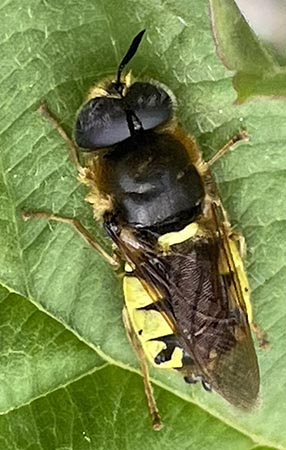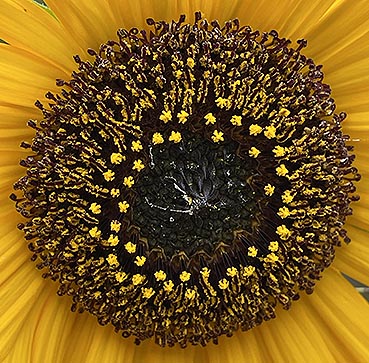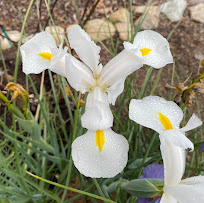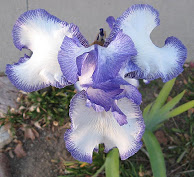AN UNUSUAL INSECT: THE HOVER FLY, IN SOUTHERN CALIFORNIA
Recently, I came across a most unusual looking bee-like/wasp-like insect on a plant in northern Los Angeles County, southern California. It is a moderately large insect with a broad body and two big and long, transparent wings. I had never seen a bee like this one! It reminded me of a wasp with its vivid yellow-and-black markings, yet it lacked the narrow “waist” of a wasp. After consulting my few books about insects, I was “batting zero.” None of the books even mentioned anything like what I found, let alone, figured it! Then, I turned to my computer and started looking for information about bee-like insects. Very soon, I came across “hover flies” [improperly also known as “hover bees”]. These insects, which are broader and much flatter than bees and wasps, hover over flowers (especially yellow or white flowers, e.g., sunflowers, Gazania, Iris, etc) in search of aphids. Hover flies are up to 2.5 inches long, with brightly colored yellow stripes on their abdomen. They have relatively short antennae with only a few segments. They also have one set of long, transparent wings. Not only do hover bees eat pests, they are great pollinators. Also, hoverflies do not make nests.
The hover fly I found belongs to genus Eupeodes = the western aphid-eater. This hoverfly occurs from California to Washington, most of British Columbia [western Canada], as well as Texas, Colorado, Wyoming, and Montana. Hover bees can tolerate cool weather. These insects are harmless; they mimic wasps in order to protect themselves from predators.
Shown above is a female? hover fly (Eupeodes sp.), dorsal view, 2.3 inches long) found April, 2025, on a boysenberry leaf in garden in Santa Clarita, northern Los Angeles County, southern California.
Hover-fly males look different than females. The large eyes of the males meet in the middle (forming a continuous black area), whereas the eyes of the females are separated The specimen in the above photograph looks like the eyes are somewhat separated..
Hover flies occur from March to November. They have no nests
Their classification is:
Kingdom Animalia
Phylum Arthropoa
Class Insecta
Order Diptera
Family Syrphidae
Genus Eupeodes
Species E. fumipennis
Fossil Record: As would be expected for an insect, hoverflies are poorly represented in the fossil record. The earliest known occurrence is in a lacustrine (lake) deposit of Oligocene age in France (Nidergas et al., 2018). According to this publication, it is possible that the geologic record of hoverlies is as old as the Late Cretaceous (in Siberia).
Sources of Data:
https://www.inaturalist.org.taxa This site has MANY (hundreds) photos of hover bees.
https://explorer.natureserve.org
Nidergas, V. and three others. 2018. The first pipizine hoverfly from the Oligocene of Cereste, France. Acta Paleontologica 63(6):539-548. [pdf is free and readily available].
Wikipedia






















